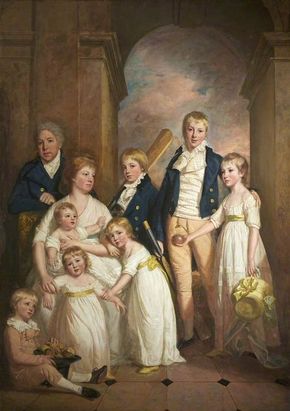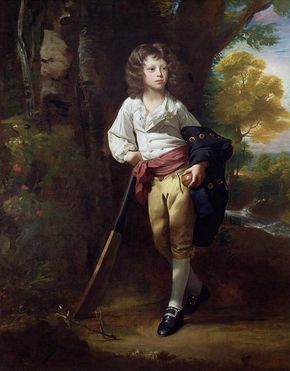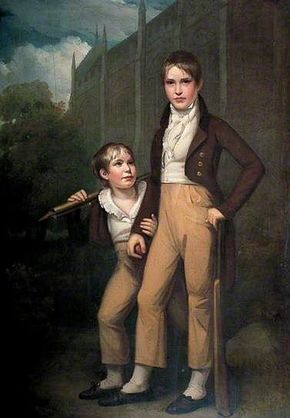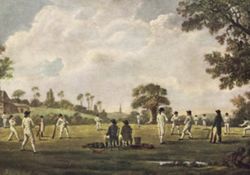Cricket: Difference between revisions
(Created page with "<table class="infobox" align="right" bgcolor="#E1E1E1" style="width:300px; font-size:90%; text-align:left; border: 1px #f18c77 solid;"> <caption style="text-align:center; fon...") |
No edit summary |
||
| Line 32: | Line 32: | ||
</table> | </table> | ||
(I freely confess to having cribbed a lot of this from Wikipedia, with the aim to give an understanding of how the game would have been played in 1811, and therefore how Robbie's players will be playing.) ''Article by [[Sharpie]]'' | |||
Cricket is a bat-and-ball game played between two teams of eleven players on a cricket field, at the centre of which is a rectangular pitch 22 yards (66 feet or one chain) long by 10 feet wide, with a wicket (a set of three wooden stumps) at each end. One team bats, attempting to score as many runs as possible, whilst their opponents field. Each phase of play is called an innings. After either ten batsmen have been dismissed or a fixed number of overs have been completed, the innings ends and the two teams then swap roles. The winning team is the one that scores the most runs, including any extras gained, during their innings. | |||
Cricket is a bat-and-ball game played between two teams of eleven players on a cricket field, at the centre of which is a rectangular 22 | |||
==Basic gameplay== | ==Basic gameplay== | ||
| Line 50: | Line 49: | ||
==Bowling== | ==Bowling== | ||
Bowling in 1811 would be underarm, with the hand rising no higher than the bowler's waist before he released the ball. The rules for bowlers in the 1744 Laws focus on the position of the back foot during delivery (i.e., it had to be behind the bowling crease) and overstepping is the only specified cause for calling a no ball. | Bowling in 1811 would be underarm, with the hand rising no higher than the bowler's waist before he released the ball. The rules for bowlers in the 1744 Laws focus on the position of the back foot during delivery (i.e., it had to be behind the bowling crease) and overstepping is the only specified cause for calling a no ball. | ||
==Basic Rules== | |||
The rules (known as 'Laws' in cricket) were first produced in print in 1755, although they had been codified in 1744. The Laws were revised in 1774 and 1788, but not revised again until 1835, so players in 1811 would follow the 1788 Laws. The main points of these were: | |||
* Stumps must be 22 inches high with a six-inch bail (there was no specified requirement for a third stump, although it was allowable to have three since a game in 1775 where a ball had passed between the two stumps without hitting either<ref>[https://en.wikipedia.org/wiki/Laws_of_Cricket#1774_code Laws of Cricket: 1774 Code], on Wikipedia</ref>. Use of a third stump was still not universal by the time the 1788 Laws were issued, which made no mention of a third stump) | |||
* the ball must weigh between five and six ounces; | |||
* overs last four balls; | |||
* the no ball is the penalty for overstepping, which means the hind foot going in front of the bowling crease (i.e., in direct line of the wicket); | |||
* the popping crease is exactly 3 feet ten inches before the bowling crease; | |||
various means of "it is out" are included; | |||
* hitting the ball twice and obstructing the field are emphatically out following experiences in the 17th century; | |||
* the wicket-keeper is required to be still and quiet until the ball is bowled; | |||
* umpires must allow two minutes for a new batsman to arrive and ten minutes between innings (meal and rain breaks presumably excepted); | |||
* the umpire cannot give a batsman out if the fielders do not appeal; | |||
* the umpire is allowed a certain amount of discretion and it is made clear that the umpire is the "sole judge" and that "his determination shall be absolute" | |||
* the bat must not exceed four inches and one quarter in the widest part; | |||
* the bowler must deliver the ball with one foot behind the bowling-crease, and within the return-crease; and shall Bowl four balls before he changes wickets, which he shall do but once in the same innings; | |||
* the striker is out if he puts his leg before the wicket, and actually prevent the ball from hitting his wicket. | |||
==Attire== | ==Attire== | ||
| Line 64: | Line 82: | ||
# [[Richard Fitzgerald I|Lord Rotherham]] ''(a known good player)'' | # [[Richard Fitzgerald I|Lord Rotherham]] ''(a known good player)'' | ||
# [[Rawdon Montgomery]], [[Earldom of Alderhan|Earl of Alderhan]] ''(a confessed poor player)'' | # [[Rawdon Montgomery]], [[Earldom of Alderhan|Earl of Alderhan]] ''(a confessed poor player)'' | ||
# Lord [[Ivor Montgomery]] | |||
# ''[[Jean-Laurent d'Aubin]]'', [[Vicomte d'Aubin]] | # ''[[Jean-Laurent d'Aubin]]'', [[Vicomte d'Aubin]] | ||
# ''[[Victor Kincaide]]'', [[Viscountcy of Hawksley|Viscount Hawksley]] | # ''[[Victor Kincaide]]'', [[Viscountcy of Hawksley|Viscount Hawksley]] | ||
# ''Lord [[Frank Harpole]]'' | # ''Lord [[Frank Harpole]]'' | ||
| Line 86: | Line 104: | ||
(Those in italics are on his list of potential players but haven't actually been asked yet. ''Note: Former characters on the list will be replaced by new characters or NPCs when he has the opportunity to ask them.'') | (Those in italics are on his list of potential players but haven't actually been asked yet. ''Note: Former characters on the list will be replaced by new characters or NPCs when he has the opportunity to ask them.'') | ||
[[Category: | ==References== | ||
[[Category:Articles]] | |||
Latest revision as of 09:30, 10 October 2017
(I freely confess to having cribbed a lot of this from Wikipedia, with the aim to give an understanding of how the game would have been played in 1811, and therefore how Robbie's players will be playing.) Article by Sharpie
Cricket is a bat-and-ball game played between two teams of eleven players on a cricket field, at the centre of which is a rectangular pitch 22 yards (66 feet or one chain) long by 10 feet wide, with a wicket (a set of three wooden stumps) at each end. One team bats, attempting to score as many runs as possible, whilst their opponents field. Each phase of play is called an innings. After either ten batsmen have been dismissed or a fixed number of overs have been completed, the innings ends and the two teams then swap roles. The winning team is the one that scores the most runs, including any extras gained, during their innings.
Basic gameplay

At the start of each game, two batsmen and eleven fielders enter the field of play. The play begins when a member of the fielding team, known as the bowler, delivers the ball from one end of the pitch to the other, towards the wicket at that end, in front of which stands one of the batsmen, known as the striker. The striker "takes guard" on a crease drawn on the pitch four feet in front of the wicket. His role is to prevent the ball from hitting the stumps by use of his bat, and simultaneously to strike it well enough to score runs. The other batsman, known as the non-striker, waits at the opposite end of the pitch near the bowler. A dismissed batsman must leave the field, and a teammate replaces him. The bowler's objectives are to prevent the scoring of runs and to dismiss the batsman. An over is a set of four (in 1811) deliveries bowled by the same bowler. The next over is bowled from the other end of the pitch by a different bowler.
The most common forms of dismissal are bowled (when the bowler hits the stumps directly with the ball), leg before wicket (when the batsman prevents the ball from hitting the stumps with his body instead of his bat), and caught (when the batsman hits the ball into the air and it is intercepted by a fielder before touching the ground).
Scoring Runs
Runs are scored by two main methods: either by hitting the ball hard enough for it to cross the boundary, or by the two batsmen swapping ends by each simultaneously running the length of the pitch in opposite directions whilst the fielders are retrieving the ball. If a fielder retrieves the ball quickly enough to put down the wicket with a batsman not having reached the crease at that end of the pitch, that batsman is dismissed (a run-out occurs). Adjudication is performed on the field by two umpires.
Bowling
Bowling in 1811 would be underarm, with the hand rising no higher than the bowler's waist before he released the ball. The rules for bowlers in the 1744 Laws focus on the position of the back foot during delivery (i.e., it had to be behind the bowling crease) and overstepping is the only specified cause for calling a no ball.
Basic Rules
The rules (known as 'Laws' in cricket) were first produced in print in 1755, although they had been codified in 1744. The Laws were revised in 1774 and 1788, but not revised again until 1835, so players in 1811 would follow the 1788 Laws. The main points of these were:
- Stumps must be 22 inches high with a six-inch bail (there was no specified requirement for a third stump, although it was allowable to have three since a game in 1775 where a ball had passed between the two stumps without hitting either[1]. Use of a third stump was still not universal by the time the 1788 Laws were issued, which made no mention of a third stump)
- the ball must weigh between five and six ounces;
- overs last four balls;
- the no ball is the penalty for overstepping, which means the hind foot going in front of the bowling crease (i.e., in direct line of the wicket);
- the popping crease is exactly 3 feet ten inches before the bowling crease;
various means of "it is out" are included;
- hitting the ball twice and obstructing the field are emphatically out following experiences in the 17th century;
- the wicket-keeper is required to be still and quiet until the ball is bowled;
- umpires must allow two minutes for a new batsman to arrive and ten minutes between innings (meal and rain breaks presumably excepted);
- the umpire cannot give a batsman out if the fielders do not appeal;
- the umpire is allowed a certain amount of discretion and it is made clear that the umpire is the "sole judge" and that "his determination shall be absolute"
- the bat must not exceed four inches and one quarter in the widest part;
- the bowler must deliver the ball with one foot behind the bowling-crease, and within the return-crease; and shall Bowl four balls before he changes wickets, which he shall do but once in the same innings;
- the striker is out if he puts his leg before the wicket, and actually prevent the ball from hitting his wicket.
Attire
In this period, cricketers generally wore black pumps, white stockings, trousers (commonly worn shorter than modern trousers are worn), shirt and waistcoat. Protective equipment was not worn until about the middle of the nineteenth century.


Cricket in The London Life
Despite being an invalid and unable to play himself, Robbie Fitzgerald has undertaken to organise a game of cricket during his convalescence. So far he has:
- Anthony Dunford, the Duke of Claitonborough
- Blake Pritchard, Marquess of Emerson
- Marcus Fairmont, Marquess of Foxford
- Henry Layton, Earl Parry
- Lord Rotherham (a known good player)
- Rawdon Montgomery, Earl of Alderhan (a confessed poor player)
- Lord Ivor Montgomery
- Jean-Laurent d'Aubin, Vicomte d'Aubin
- Victor Kincaide, Viscount Hawksley
- Lord Frank Harpole
- Lord Gabriel Pritchard (a good player)
- Mr Adrian Carey
- Mr Kit Carlisle (a good player)
- Captain Arthur Cartwright
- Sir Perry Bexley
- Sir Will Devenish
- Mr Charlie Devenish
- Mr Julian Freye
- Mr Fred Lazenby (a good player)
- Mr Michael Randal
- Mr Maximilian Sandeford-Wrey
- Mr Geoffrey Stapleton (a poor player)
- Mr Ira Wilson
- Major Gerald Stapleton - to umpire?
- Major Felix Sutcliffe - to umpire?
(Those in italics are on his list of potential players but haven't actually been asked yet. Note: Former characters on the list will be replaced by new characters or NPCs when he has the opportunity to ask them.)
References
- ↑ Laws of Cricket: 1774 Code, on Wikipedia
